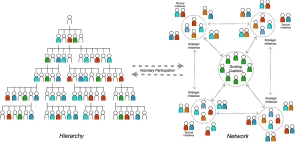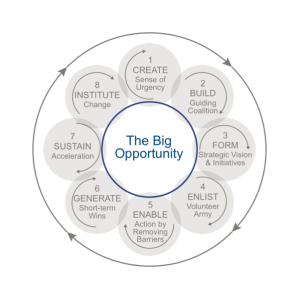In a world of accelerating change, traditional hierarchies are often too slow to change direction. Kotter in his book Accelerate: Building Strategic Agility for a Faster-Moving World, advocates a new system—a second, more agile, network-like structure that operates in concert with the hierarchy to create what he calls a “dual operating system”—one that allows organizations to capitalize on rapid-fire strategic challenges and new directions. The hierarchy and the network coexist to drive efficiency and innovation.
This second operating system or network-like structure mimics successful enterprises in their entrepreneurial phase. Networks are more agile because bottlenecks don’t exist and you have many people driving important change and from everywhere. Its a distributed leadership model. The two systems work as one with a constant flow of information between them.
Whilst traditional hierarchies are built to minimize risk, these “accelerator networks” are free to take risks and innovate. The hierarchy doesn’t manage the network, rather they work in synergy. Essentially you create structures that can short circuit the way things have always been done. An essential ingredient of change. Kotter, a leadership and change management expert, advocates eight accelerators to accelerate change within an organization.
This year we have emulated some of Kotter’s work and created some “accelerator networks” around the three key areas of Innovation, Pedagogy & Assessment. By establishing urgency, opening membership on these networks to all and establishing some big opportunities around key themes, we have seen innovation come from everywhere and change accelerate. Whilst there are quite a few reasons for this, these “accelerator networks” in particular have caused a shift to immediate action by creating a distributed leadership platform for us to discuss and implement organizational change in synergy with the traditional hierarchy.
Steve Collis from NBCS was recently talking about this exact idea at DigiTech By The Bay. John Burns is doing the same with his HackSIS event where he is inviting people to create, design, break, reverse engineer & reimagine facets of their school community by posing big questions that create opportunities.
There are many change management frameworks around but I think Kotter’s is a good one.


Hi Adrian,
I am launching a network to potentially redesign the way we deliver Co-curricular here at Shore. Would love to chat on your experiences at Geelong College – pitfalls, framing, sustainability, outcomes etc. Am using the Kotter framework here after chatting closely with Cam Paterson.
Please let me know if this appeals?
Best
Andy
ANDREW QUINANE
Director of Activities
T 02 9923 2277 M 0408 492 921
Blue Street North Sydney
PO Box 1221 North Sydney NSW 2059
http://www.shore.nsw.edu.au
LikeLike
Hi Andy,
Thanks for the comment. Very happy to chat at some stage. Let me know when suits.
LikeLike